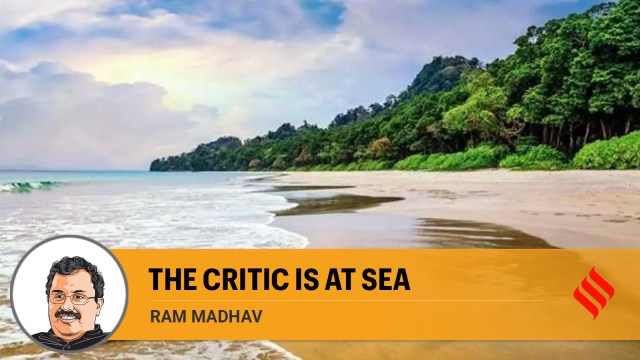
Senior Congress leader Sonia Gandhi penned an article in a prestigious English daily recently, criticising the Great Nicobar Island Development Project being undertaken by the Narendra Modi government. All modern development projects entail environmental concerns, like the displacement of local communities and the harm caused to flora and fauna. The Rs 81,000-crore mega project conceived by the NITI Aayog and implemented by the Andaman and Nicobar Islands Integrated Development Corporation (ANIIDCO) is no exception.
Great Nicobar Island is the largest among the main islands in the Nicobar Islands. Campbell Bay and Indira Point are known tourist places. Indira Point, originally called Pygmalion Point, but renamed after the former prime minister who visited that place in 1984, is the southernmost point of India. It is just 145 km (about 80 nautical miles) from the Aceh Province of Indonesia.
The proposed mega development project is expected to come up in the southern part. It includes the development of an international container terminal, an international greenfield airport, a solar power plant and two greenfield cities. Once completed, it has the potential to compete with port cities like Singapore. Sonia Gandhi has accused the government of causing severe environmental harm to trees and turtles, besides destroying abodes of around 1,200 aboriginal people belonging to two tribes — the Nicobarese and the Shompen — in the name of this project.
It is important to understand why such a mega project is being contemplated by the government. India’s dependence on the Indian Ocean for its developmental and security needs cannot be overstated. Almost 80 per cent of its external trade and 100 per cent of energy imports happen through this region. Moreover, the Indian Ocean Region has emerged as the most influential sea route for global commerce and connectivity. Home to some of the world’s most populous countries and fastest growing economies, along with massive militaries, this region has emerged as the “21st century global power axis”.
American naval officer and historian, Admiral Alfred T Mahan, insisted a century ago that “whoever attains maritime supremacy in the Indian Ocean would be a prominent player on the international scene”. Diplomat and historian K M Panikkar, too, warned, “It should be remembered that the peninsular character of the country and the essential dependence of its trade on maritime traffic give the sea a preponderant influence on its destiny.”
Yet, successive governments after Independence neglected enhancing India’s maritime capability. While Panikkar called for understanding India’s “peninsular character”, governments remained prisoners of a “continental mindset”. For several decades, the Indian Navy remained a “brown water navy” capable only of tackling littoral challenges. In the early 2000s, there was finally the realisation that power projection in the IOR is critical to our future as well as for maintaining peace in the region.
The Indian Ocean neighbourhood is a crowded space today with vessels from all major countries crisscrossing its waters. Next-generation undersea cable communication networks proliferate. India is expected to face maritime challenges not only from other navies but also from piracy, seaborne terrorism, climate challenges, human and contraband trafficking, illegal and unregulated fishing, arms running, poaching, and humanitarian challenges like evacuations and disaster management and relief. Nearby are security hotspots like Iran, Afghanistan and Pakistan and maritime chokepoints like the Strait of Hormuz, Malacca Strait and Sunda Strait.
The Nicobar Islands are an important linchpin in this region. Developing maritime infrastructure is critical to India’s security and development, something that the Congress leadership refuses to acknowledge. Sonia Gandhi went to Indira Point in 2009 to install a statue of Indira Gandhi on acquired forest land. Concerns were raised at that time about the environmental impact of the statue project. Those objections were overruled. It is hypocritical today for her to cite the same reasons to criticise the Modi government’s project, which certainly has much greater implications for India’s security and development than a statue.
This is not to suggest that the environmental concerns raised by her are not relevant. However, the government took all those aspects into consideration before announcing the project. It involved not just government agencies but also academic ones like IIT, NIOT, NCCR and NIO for assessing the environmental impact and suggesting remedies. Only 166 sq km has been allocated for the project. While a couple of villages will be relocated, not a single habitation of the tribes will be touched. For the remaining acquired land, “compensatory afforestation” is being adopted by choosing the Aravalli mountain range ecosystem, the oldest in India but also among the most degraded. New conservation plans are prepared for the Nicobar megapodes, crocodiles and corals.
The Great Nicobar Island Development Project is a crucial peg in our Viksit Bharat vision. Besides providing jobs to the people in Andaman and Nicobar and outside, it will also catapult India into the league of major maritime powers in the Indian Ocean Region, all this while taking all necessary pre-emptive and prospective measures for environmental preservation.
Is there something more sinister in the opposition to the project than just environmental concerns?
The writer, president, India Foundation, is with the BJP. Views are personal